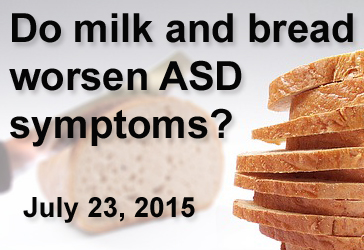Archives
July, 2015
Select a different month in the archive
Diagnosis Swap May Increase ASD Prevalence
By Shana R. Spindler, Ph.D. on July 28, 2015
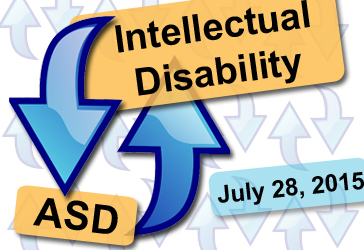
Background: Autism Spectrum Disorder (ASD) is characterized by impaired social and communication skills and the presence of restrictive or repetitive behaviors. The United States Centers for Disease Control (CDC) estimates the current prevalence of ASD at 1 in 68 children. This is a sharp increase from the CDC estimate of 1 in 150 children with ASD in 2002.
What’s new: On July 22, 2015, the American Journal of Medical Genetics published a study comparing the prevalence of ASD with other comorbid conditions, such as intellectual disability (ID), among 6.2 million children enrolled in special education programs in the United States. The researchers report that a decrease in ID diagnosis accounts for about 64 percent of the increase in autism prevalence between 2002 and 2010. Age of the child appears to influence the re-categorization of diagnosis, with older children seeing a greater shift toward autism diagnosis than younger children.
Why it’s important: These data suggest that healthcare professionals are using the diagnosis of ASD in place of comorbid classifications more often, and this accounts, in part, for the increase in ASD rates over the last decade.
Help me understand :
| Source(s) : |
| Tweet |
Study Questions Gluten- and Casein-Free Diets for ASD
By Chelsea E. Toledo, M.A. on July 23, 2015
Background: Autism Spectrum Disorder (ASD) has been linked to gastrointestinal issues, and some families follow specific dietary guidelines to allay both digestive and behavioral symptoms. In particular, these diets have excluded gluten and casein—proteins found in bread and milk, respectively. While some healthcare professionals recommend a gluten-free, casein-free diet—commonly known as a GFCF diet—studies that confirm its efficacy are lacking.
What’s New: On July 4, 2015, the journal Acta Paediatrica published a study exploring the effects of gluten and casein on the gastrointestinal and behavioral symptoms of children with ASD as well as the urine concentration of a protein previously associated with behavioral issues in autistic children. The researchers performed a double-blind, randomized clinical study on children between the ages of 4 and 7 with severe behavioral issues related to ASD, all of whom were already on a gluten- and casein-free diet. After giving a gluten-casein supplement to 38 children and a rice meal placebo to 36 children for one week, they found no significant difference between the two groups in behavior, urinary protein expression, and level of gastrointestinal disruption.
Why it’s important: While previous studies have evaluated the effects of eliminating gluten and casein from the diets of children with ASD, this is the first study to explore the results of adding the proteins back in. Future studies could evaluate the long-term effects of gluten and casein on behavior and gastrointestinal symptoms, given the limited exposure time to these proteins in this study.
Help me understand :
| Source(s) : |
| Tweet |
Autism Could be Indicated by Sniffing Patterns
By Chelsea E. Toledo, M.A. on July 14, 2015
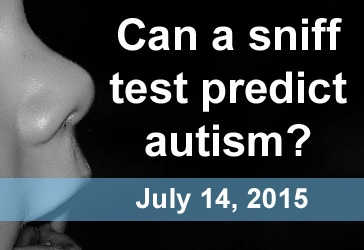
Background: Sensory-motor coordination involves integration between the parts of the brain that receive and interpret stimuli and those that facilitate action in response. For example, upon touching a hot surface, people immediately remove their hands. Studies have suggested that sensory-motor coordination is atypical in people with autism spectrum disorder (ASD).
What’s New: On July 2, 2015, the journal Current Biology published a study exploring the response to odors in children with and without ASD. The researchers used a device to measure the time to sniff and duration of sniff for 36 children between the ages of 4 and 11 who were presented with pleasant and foul odors. They found that the 18 typically developing children followed the same sniffing patterns seen in adults; they would sniff pleasant odors for longer periods of time, but respond with brief sniffs when presented with foul odors. The 18 children with ASD, however, sniffed both pleasant and foul odors for the same amount of time. Using the device, the researchers were able to predict 81 percent of ASD cases.
Why it’s important: This study suggests that the olfactory response is different in children with ASD, with more pronounced differences in children with higher degrees of social impairment. Future research could determine whether the researchers’ method, which requires no verbal response, could be used to help diagnose the disorder in very young children to allow for early intervention.
Help me understand :
| Source(s) : |
| Tweet |
Study Probes Memory and Language Patterns in ASD
By Chelsea E. Toledo, M.A. on July 7, 2015
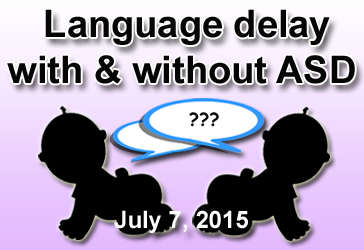
Background: While differences in communication comprise a core feature of autism spectrum disorder (ASD), those with the disorder experience a wide range of language abilities and impairments. Studies have compared language delay in children with ASD to language delay in those without the disorder—demonstrating an overlap in the difficulties they encounter producing sounds, words, and language.
What’s New: On June 14, 2015, the Journal of Neurodevelopmental Disorders published a study assessing language impairment in children with and without ASD. The researchers administered a battery of language tests to 60 children between 5 and 8 years of age. They found that children who experienced language impairments (both with and without ASD) had more trouble remembering words that they had heard than children with ASD and no language impairment. However, the ability to repeat non-word sounds differed among children with language delay—those with ASD outperformed those without ASD in repeating short non-word sounds.
Why it’s important: This study suggests that the neurodevelopmental factors leading to language delay in children with ASD are different from those leading to impairments in children without the disorder. Long-term studies of both populations could shed light on how patterns in their language and memory compare as they mature.
Help me understand :
| Source(s) : |
| Tweet |
Size of Brain Area May Predict ASD in Infants
By Chelsea E. Toledo, M.A. on July 1, 2015
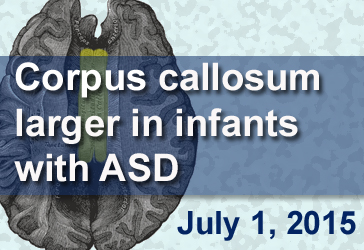
Background: “White matter” refers to the parts of the brain that transmit signals between brain regions. The brain’s largest white matter connection, the corpus callosum, is a thick bundle of fibers connecting the brain’s hemispheres and facilitating communication between them. Numerous studies have shown that the corpus callosum is smaller in adults and children with autism spectrum disorder (ASD) than in their typically developing counterparts.
What’s New: On May 3, 2015, the journal Brain published the first study focusing on the corpus callosum in infants at risk of developing ASD. The researchers scanned the brains of 378 children—270 with older siblings diagnosed with ASD—at 6, 12, and then 24 months of age. Fifty-seven of those children fit the ASD profile at 24 months of age. In those children, the corpus callosum was much thicker—especially at the 6- and 12-month time points, with differences diminishing as children approached 2 years of age. The finding held even when the researchers controlled for brain size, which studies have shown is larger in infants with ASD.
Why it’s important: This is the first study to examine how the size of the corpus callosum during infancy relates to ASD diagnosis. Future research could examine the biological mechanisms that lead to changes in relative corpus callosum size from infancy to child- and adulthood in those with autism. Several lines of evidence point to abnormalities in the way neuron growth and insulation is managed in the brain.
Help me understand :
| Source(s) : |
| Tweet |


